Medical research is an information-generating endeavour, the primary purpose of which is to disseminate findings in the interest of humanity to advance human health and wellbeing. It plays an essential role in understanding the mechanisms of diseases, developing new treatments and improving existing healthcare practices [1]. It is a complicated system comprising a wide range of elements and carrying both qualitative and quantitative value. To evaluate this scientific research, the scientometric technique is necessary. The field of scientometrics examines the quantitative dimensions of scientific knowledge, including its creation, distribution and utilisation. Its objective is to enhance ones comprehension of the social dynamics underlying scientific research [2]. It reveals scientific phenomena and processes [3].
Scientometric researchers analyse developments in scientific subjects, the influence of research publications, authorship, journals, publication support and the distribution of scientific information using a methodological approach, such as Bradford’s law, Lotka’s law, citation analysis techniques, co-citation analysis techniques, term dynamics, collaboration networks, social network analysis, bibliographic coupling and text mining [4]. The scientometric technique is carried out using databases such as the Web of Science or Scopus. These databases are widely accepted and helpful in understanding the development of literature, as well as trends in certain subjects, authorship and journals [5]. Thus, scientometric analysis was conducted to evaluate and analyse the research output growth, international collaboration and impact of JSSAHER.
JSSAHER, formerly JSS University, is a deemed university located in Mysuru, Karnataka, India. It was founded in 2008 under Section 3 of the UGC Act of 1956 and is affiliated with JSS Mahavidyapeetha, which operates numerous educational institutions. This deemed-to-be university has an A+ grade from National Assessment and Accreditation Council (NAAC) and is recognised by the Ministry of Education (3.48 CGPA) [6]. The University Grants Commission (UGC) has designated JSSAHER as a Category-I deemed-to-be university [7].
JSSAHER has a wide network of institutes, including departments of Medicine, Dentistry and Pharmaceutical Sciences, operating at the Mysore campus and Ooty in Tamil Nadu, India. More than 600 faculty members and over 2,000 students are pursuing their studies in these institutes. JSSAHER has collaborated with many foreign universities, such as La Trobe University (Australia), Khon Kaen University (Thailand), Howard University (Washington DC), and the University of Illinois (Chicago, America).
JSSAHER has been consistently ranked among the top 50 universities in India for the past eight years (2016-2023). In 2023, it became the first institution in Karnataka to receive a Five-Star aggregate rating from Quacquarelli Symonds, UK, and the first health science-oriented institution in India. JSSAHER places immense importance on research, leading to new advancements in the field of medicine through drug therapy, the discovery of new drugs and patents [7].
The need for this study arises from JSSAHER’s growing prominence in scientific research, highlighting its role in addressing global health challenges and advancing academic collaborations. This study aims to analyse the research contributions of JSSAHER, focusing on its publication trends, citation metrics and international collaborations. Conducted between June 2024 and September 2024, this analysis seeks to provide actionable insights into the institution’s research impact and future directions.
Materials and Methods
This observational bibliometric study was conducted at JSSAHER, Mysuru, Karnataka, India, using data collected from the Web of Science database. The study period covered research outputs from 1996 to 2023, with data retrieval completed between June 2024 and September 2024. Ethical approval was not applicable, as the study involved secondary data analysis.
Inclusion criteria: The study included all publications authored by researchers affiliated with JSSAHER, retrieved using the institutional name as the affiliation keyword. Only documents published between 1996 and 2023 were considered.
Exclusion criteria: Publications outside this period or those without proper institutional affiliation were excluded from the study.
Methodology and parameters studied: The parameters evaluated included publication growth trends, citation analysis, authorship patterns, collaboration networks and keyword analysis. The study aimed to identify research productivity, international collaboration and thematic trends in JSSAHER’s scholarly output.
Statistical Analysis
The retrieved data were analysed using scientometric tools, including Biblioshiny, VOSviewer and CiteSpace, along with MS Excel for tabulation and visualisation.
Data Analysis
Overview of JSSAHER’s research output: [Table/Fig-1] analysis revealed that JSSAHER produced 4,680 publications from 1996 to 2023, with an annual growth rate of 13.87%. The “average age of documents” refers to the mean time since the publication of each document in the dataset, which in this case was calculated as 5.97±1.23 years. This metric provides an understanding of the relative recency of the institution’s research output. The documents received an average of 23.47±8.62 citations per document. Of the total publications, 1,203 were international collaborations, accounting for 25.71% of the total research output. These figures highlight strong global engagement and the diversity of research topics covered by JSSAHER scholars, as evidenced by the use of 7,895 keywords plus and 11,724 author keywords.
Comprehensive overview of JSSAHER’s research output (1996-2023).
| Description | Results |
|---|
| Sources (Journals, Books, etc.,) | 1,238 |
| Documents | 4,680 |
| Annual growth rate (%) | 13.87 |
| Document average age (mean±SD) | 5.97±1.23 |
| Average citations per document (mean±SD) | 23.47±8.62 |
| References | 1,57,665 |
| Keywords plus (ID) | 7,895 |
| Author’s keywords (DE) | 11,724 |
| Authors | 25008 |
| Co-authors per document | 5.37±2.14 |
| International co-authorship % (1203) | 25.71 |
Annual Research Growth and Impact of JSSAHER Research Documents
In [Table/Fig-2], JSSAHER’s research output showed consistent growth, with 649 (13.86%) publications in 2023 and the highest annual output of 662 (14.14%) publications in 2022. While citation impact varied across years, the highest Average Citations per Document (ACD) was recorded for publications from 2018, with an impressive 91.22 ACD. A significant h-index of 42 was observed for papers published in 2020, reflecting the influence and quality of research during that period. This trend highlights JSSAHER’s growing prominence in impactful research over the years.
JSSAHER’s annual research growth and citation impact (2004-2023).
| Year | Total documents | % of 4680 | Total citations | ACD | h-Index |
|---|
| 2023 | 649 | 13.86 | 2,313 | 3.56 | 18 |
| 2022 | 662 | 14.14 | 5,665 | 8.56 | 31 |
| 2021 | 589 | 12.58 | 7,360 | 12.5 | 38 |
| 2020 | 464 | 9.91 | 11,064 | 23.84 | 42 |
| 2019 | 315 | 6.73 | 8,147 | 25.86 | 32 |
| 2018 | 245 | 5.23 | 22,350 | 91.22 | 34 |
| 2017 | 207 | 4.42 | 16,966 | 81.96 | 30 |
| 2016 | 241 | 5.15 | 14,550 | 60.37 | 27 |
| 2015 | 219 | 4.67 | 1,989 | 9.09 | 22 |
| 2014 | 197 | 4.20 | 2,098 | 10.65 | 22 |
| 2013 | 230 | 4.91 | 2,371 | 10.31 | 24 |
| 2012 | 153 | 3.26 | 2,445 | 15.98 | 28 |
| 2011 | 117 | 2.5 | 1,832 | 15.66 | 23 |
| 2010 | 108 | 2.30 | 2,543 | 23.55 | 25 |
| 2009 | 74 | 1.58 | 1,018 | 13.76 | 17 |
| 2008 | 89 | 1.90 | 1,529 | 17.18 | 19 |
| 2007 | 52 | 1.11 | 722 | 13.88 | 16 |
| 2006 | 19 | 0.40 | 379 | 19.95 | 9 |
| 2005 | 10 | 0.21 | 175 | 17.5 | 6 |
| 2004 | 17 | 0.36 | 752 | 44.42 | 11 |
ACD: Average citations per document
The annual publication trend of JSSAHER from 2004 to 2023 indicates a steady increase in research output. The number of publications surged significantly after 2015, reflecting the institution’s growing emphasis on research activities. The highest annual output was recorded in 2022, with 662 publications. This upward trajectory underscores JSSAHER’s consistent efforts to enhance its scholarly contributions over the years [Table/Fig-3].
JSSAHER’s Annual Growth Trend in Research Publications (2004-2023).
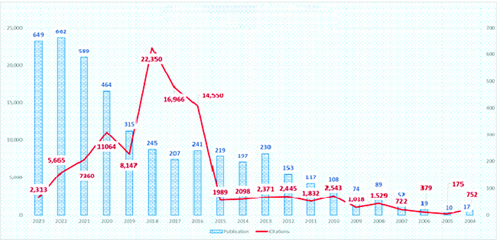
Document-wise analysis of JSSAHER research documents: The analysis of JSSAHER’s publications reveals that the majority, 3,136 (68.01%), are research articles, emphasising the institution’s strong focus on generating original empirical research. Review articles constitute 744 (15.85%), showcasing a synthesis of existing knowledge, while a smaller fraction, 104 (2.22%), includes book chapters, conference papers, and early-access articles. This distribution highlights JSSAHER’s commitment to contributing diverse and impactful scholarly works across multiple formats [Table/Fig-4].
Document-wise analysis of JSSAHER publications.
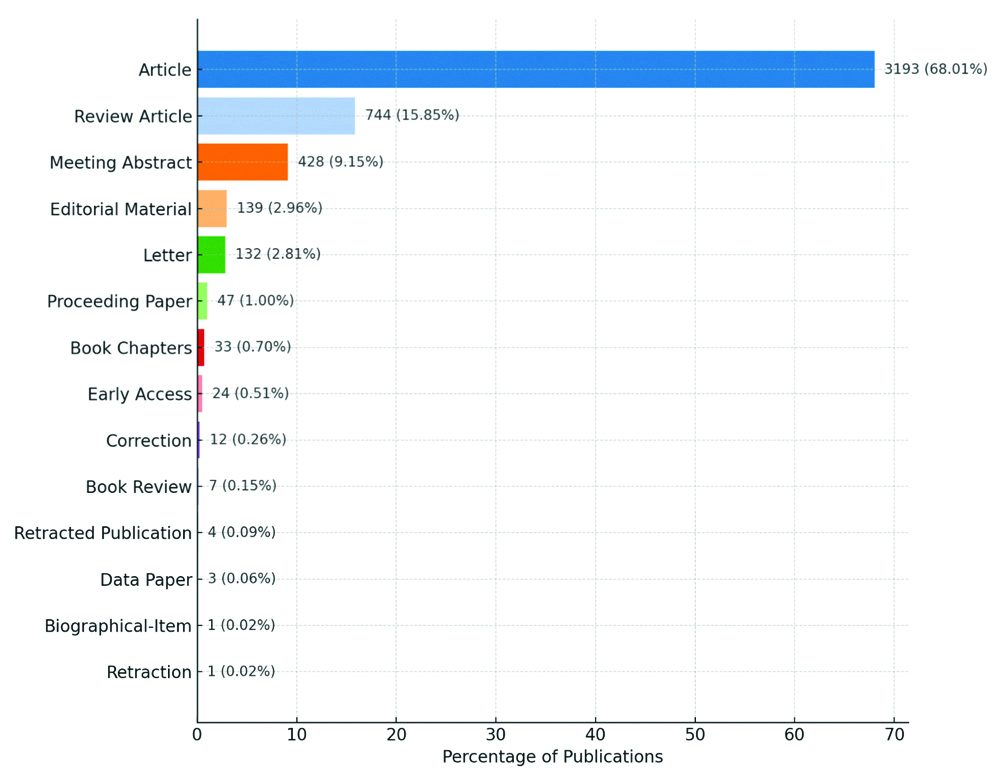
Authorship pattern of JSSAHER research documents: The authorship analysis shows that JSSAHER’s research is predominantly collaborative, with most publications involving four or more authors. Single-author publications accounted for only 118 (2.52%) of the total, while the highest percentage, 862 (18.41%), featured four co-authors. Larger research teams (5-10 authors) also contributed significantly, reflecting the institution’s emphasis on interdisciplinary and collaborative research practices [Table/Fig-5].
Authorship pattern of JSSAHER research documents.
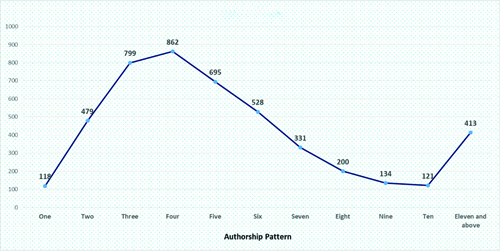
Most productive authors: In [Table/Fig-6], the analysis highlights Mahesh PA as the most productive and impactful author, with 172 publications, 39,239 citations, and a high h-index of 54, showcasing significant research influence. Other notable contributors include Sathyanarayana Rao TS and Suresh Bhojraj, who demonstrated moderate productivity and citation impact. Authors like Madhunapantula SubbaRao V achieved a high citation-per-document (47.5), indicating impactful niche research. These profiles illustrate the varied levels of productivity and influence among JSSAHER’s researchers, with strong contributions to both national and international collaborations.
Scientometric profile of top productive and most impactful authors in JSSAHER.
| Author | TD | TC | CPD | HI | RCI | ICD | TLS |
|---|
| Mahesh PA | 172 | 39239 | 211.38 | 54 | 5.512871 | 17.2 | 344 |
| Sathyanarayana Rao TS | 156 | 1776 | 11.38 | 20 | 0.296795 | 15.6 | 312 |
| Ramesh Madhan | 117 | 544 | 4.67 | 12 | 0.121795 | 11.7 | 234 |
| Suresh Bhojraj | 106 | 2372 | 22.38 | 25 | 0.583679 | 10.6 | 212 |
| Shivamallu Chandan | 97 | 1073 | 11.06 | 16 | 0.288449 | 9.7 | 194 |
| Ramu Ramith | 89 | 1285 | 14.44 | 22 | 0.376601 | 8.9 | 178 |
| Gowda Devegowda Vishakante | 80 | 796 | 9.55 | 16 | 0.249068 | 8 | 160 |
| Madhunapantula, SubbaRao V | 63 | 1487 | 47.5 | 21 | 1.238818 | 6.3 | 126 |
| Kishor Manohar Rao | 62 | 142 | 15.18 | 9 | 0.3959 | 6.2 | 124 |
| Ram, Dushad | 57 | 217 | 35.89 | 9 | 0.936025 | 5.7 | 114 |
TD: Total documents; TC: Total citations; CPD: Citations per documents; HI: h-Index; ICD: International collaborative documents; TLS: Total link strength; RCI: Relative citation index
The correlation analysis revealed a strong relationship between Total Citations (TC) and metrics such as Citations Per Document (CPD), h-index (HI), and Relative Citation Index (RCI), with values of 0.98, 0.93, and 0.98, respectively. This indicates that citation counts significantly drive the impact metrics. Similarly, Total Documents (TD) showed strong correlations with International Collaborative Documents (ICD) and Total Link Strength (TLS), both at 1.0, reflecting JSSAHER’s emphasis on global collaboration and interconnected research. These insights highlight the interconnected nature of publication productivity and citation impact [Table/Fig-7].
Correlation matrix analysis.
| TD | TC | CPD | HI | RCI | ICD | TLS |
|---|
| TD | 1 | 0.66812 | 0. 539707 | 0. 711681 | 0. 539236 | 1 | 1 |
| TC | 0. 66812 | 1 | 0. 977083 | 0. 929151 | 0. 976962 | 0.66812 | 0.66812 |
| CPD | 0. 539707 | 0. 977083 | 1 | 0. 898178 | 0. 999999 | 0. 539707 | 0.539707 |
| HI | 0. 711681 | 0. 929151 | 0. 898178 | 1 | 0. 897842 | 0. 711681 | 0.711681 |
| RCI | 0. 539236 | 0. 976962 | 0. 999999 | 0. 897842 | 1 | 0. 539236 | 0.539236 |
| ICD | 1 | 0.66812 | 0. 539707 | 0. 711681 | 0. 539236 | 1 | 1 |
| TLS | 1 | 0.66812 | 0. 539707 | 0. 711681 | 0. 539236 | 1 | 1 |
Author productivity according to Lotka’s Law
The analysis of author productivity at JSSAHER revealed a typical Lotka’s Law distribution, where a small group of authors contributes the majority of publications, while most authors contribute only one or two papers. More than 60% of the authors fall into the latter category, indicating a significant core group of prolific researchers who drive the institution’s scholarly output. This distribution underscores the balance between widespread participation and the contributions of a dedicated group of high-producing researchers [Table/Fig-8].
Application of Lotka’s Law on JSSAHER author productivity.

Most Productive Sources
The Journal of Clinical and Diagnostic Research leads with 174 publications, highlighting its significance in disseminating JSSAHER’s research, as shown in [Table/Fig-9]. The Indian Journal of Psychiatry follows closely with 171 articles, showcasing the institution’s focus on mental health studies. Journals such as Pharmacoepidemiology and Drug Safety, and the Indian Journal of Pharmacology also feature prominently, reflecting the emphasis on pharmacology and drug safety. These journals collectively represent JSSAHER’s diverse research output, emphasising health sciences and clinical studies in high-impact platforms.
Profile of the top 10 journals that have published the most documents on JSSAHER research.
| Journal | h_index | g_index | m_index | TC | NP | PY_start |
|---|
| Journal of Clinical and Diagnostic Research | 13 | 20 | 0.867 | 811 | 174 | 2010 |
| Indian Journal of Psychiatry | 17 | 31 | 1.417 | 1278 | 171 | 2013 |
| Pharmacoepidemiology and Drug Safety | 2 | 10 | 0.091 | 113 | 114 | 2003 |
| Int Journal of Pharm Science Research | 8 | 11 | 0.571 | 223 | 92 | 2011 |
| Value Health | 1 | 1 | 0.077 | 6 | 80 | 2012 |
| Indian Journal of Pharmacology | 9 | 15 | 0.5 | 257 | 70 | 2007 |
| Journal of Evol Med Dent Science | 2 | 2 | 0.167 | 22 | 70 | 2013 |
| Indian J Pharm Educ Res | 8 | 11 | 0.444 | 186 | 66 | 2007 |
| Int. Journal of Health Allied Science | 5 | 9 | 0.714 | 128 | 58 | 2018 |
| Journal of Young Pharm | 8 | 13 | 0.533 | 215 | 54 | 2010 |
TC: Total citations; NP: Number of publications; PY_start: First article published year
Most Impactful Documents
In [Table/Fig-10], the most cited paper, authored by James SLG et al., received 6747 citations, demonstrating its significant global impact. Other highly cited works, such as those by Fitzmaurice C et al., (4208 citations) and Stanaway JD et al., (4066 citations), highlight JSSAHER’s contribution to global health and disease burden studies. These influential publications, primarily featured in high-impact journals like The Lancet, underline the institution’s pivotal role in advancing knowledge in public health and epidemiology [8-17].
Analysis of JSSAHER’s most cited papers [8-17].
| Details of the paper | TC | TCpY |
|---|
| James SLG, Abate D, Abate KH, Abay SM, Abbafati C, Abbasi N, et al. Global, regional, and national incidence, prevalence, and years lived with disability for 354 diseases and injuries for 195 countries and territories, 1990-2017: A systematic analysis for the Global Burden of Disease Study 2017. LANCET. 2018;392(10159):1789-858. http://dx.doi.org/10.1016/S0140-6736(18)32279-7 [8]. | 6747 | 1124.5 |
| Fitzmaurice C, Allen C, Barber RM, Barregard L, Bhutta ZA, Brenner H, et al. Global, regional, and national cancer incidence, mortality, years of life lost, years lived with disability, and disability-adjusted life-years for 32 cancer groups, 1990 to 2015. A systematic analysis for the Global Burden of Disease Study. JAMA Oncol. 2017;3(4):524-48. http://dx.doi.org/10.1001/jamaoncol.2016.5688 [9]. | 4208 | 601.14 |
| Stanaway JD, Afshin A, Gakidou E, Lim SS, Abate D, Abate KH, et al. Global, regional, and national comparative risk assessment of 84 behavioural, environmental and occupational, and metabolic risks or clusters of risks for 195 countries and territories, 1990-2017: A systematic analysis for the Global Burden of Disease Study 2017. LANCET. 2018;392(10159):1923-94. http://dx.doi.org/10.1016/S0140-6736(18)32225-6 [10]. | 4066 | 677.66 |
| Wang H, Naghavi M, Allen C, Barber RM, Bhutta ZA, Carter A, et al. Global, regional, and national life expectancy, all-cause mortality, and cause-specific mortality for 249 causes of death, 1980-2015: A systematic analysis for the Global Burden of Disease Study 2015. LANCET. 2016;388(10053):1459-544. http://dx.doi.org/10.1016/S0140-6736(16)31012-1 [11]. | 3718 | 464.75 |
| Roth GA, Abate D, Abate KH, Abay SM, Abbafati C, Abbasi N, et al. Global, regional, and national age-sex-specific mortality for 282 causes of death in 195 countries and territories, 1980-2017: a systematic analysis for the Global Burden of Disease Study 2017. LANCET. 2018;392(10159):1736-88. http://dx.doi.org/10.1016/S0140-6736(18)32203-7 [12]. | 3401 | 566.83 |
| Vos T, Allen C, Arora M, Barber RM, Bhutta ZA, Brown A, et al. Global, regional, and national incidence, prevalence, and years lived with disability for 310 diseases and injuries, 1990-2015: A systematic analysis for the Global Burden of Disease Study 2015. LANCET. 2016;388(10053):1545-602. http://dx.doi.org/10.1016/s0140-6736(16)31678-6 [13]. | 3092 | 386.5 |
| Abbafati C, Abbas KM, Abbasi M, Abbasifard M, Abbasi-Kangevari M, Abbastabar H, et al. Global burden of 369 diseases and injuries in 204 countries and territories, 1990-2019: A systematic analysis for the Global Burden of Disease Study 2019. LANCET. 2020;396(10258):1204-22 [14]. | 3226 | 806.5 |
| Forouzanfar MH, Afshin A, Alexander LT, Anderson HR, Bhutta ZA, Biryukov S, et al. Global, regional, and national comparative risk assessment of 79 behavioural, environmental and occupational, and metabolic risks or clusters of risks, 1990-2015: A systematic analysis for the Global Burden of Disease Study 2015. LANCET. 2016;388(10053):1659-724. http://dx.doi.org/10.1016/S0140-6736(16)31679-8 [15]. | 3176 | 397 |
| Naghavi M, Abajobir AA, Abbafati C, Abbas KM, Abd-Allah F, Abera SF, et al. Global, regional, and national age-sex specific mortality for 264 causes of death, 1980-2016: a systematic analysis for the Global Burden of Disease Study 2016. LANCET. 2017;390(10100):1151-210. http://dx.doi.org/10.1016/S0140-6736(17)32152-9 [16]. | 2781 | 397.28 |
| Griswold MG, Fullman N, Hawley C, Arian N, Zimsen SRM, Tymeson HD, et al. Alcohol use and burden for 195 countries and territories, 1990-2016: A systematic analysis for the Global Burden of Disease Study 2016. LANCET. 2018;392(10152):1015-35. http://dx.doi.org/10.1016/S0140-6736(18)31310-2 [17]. | 2142 | 357 |
TCpY: Total citations per year
Discipline-Wise Contribution of JSSAHER Research Documents
Analysis of JSSAHER’s research output is dominated by Pharmacology and Pharmacy, contributing 26.72% of the total publications, which reflects the institution’s focus on therapeutic innovations. General Medicine (11.24%) and Medicinal Chemistry (5.85%) are also prominent, showcasing strengths in clinical research and drug development. Other notable disciplines include Biochemistry and Molecular Biology (5.75%), Psychiatry (4.67%), and Public Health (4.57%), indicating a multidisciplinary approach that addresses diverse healthcare challenges. This distribution highlights JSSAHER’s commitment to advancing research across key health science domains [Table/Fig-11].
Top ten distribution of documents across disciplines.
| Disciplines | Documents | 4680% of |
|---|
| Pharmacology pharmacy | 1204 | 25.72 |
| Medicine general internal | 526 | 11.24 |
| Chemistry medicinal | 274 | 5.85 |
| Biochemistry molecular biology | 269 | 5.75 |
| Psychiatry | 214 | 4.57 |
| Chemistry multidisciplinary | 214 | 4.57 |
| Public environmental occupational health | 210 | 4.48 |
| Dentistry oral surgery medicine | 185 | 3.95 |
| Medicine research experimental | 126 | 2.69 |
| Oncology | 119 | 2.54 |
Most Commonly Occurring Keywords
The [Table/Fig-12] keyword analysis highlights “in-vitro,” “nanoparticles,” and “oxidative stress” as the most frequently co-occurring terms, indicating JSSAHER’s research focus on laboratory studies and biological mechanisms. Clusters also reveal strong associations with terms like “prevalence,” “risk,” and “COVID-19,” showcasing work in epidemiology and public health. These co-occurrence patterns underscore the institution’s multidisciplinary research, bridging basic science and clinical applications.
Most frequently co-occurred keywords.
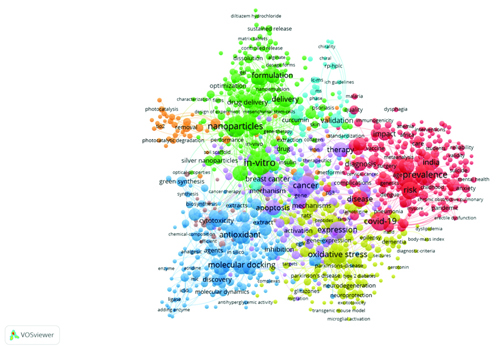
Global Collaboration Analysis of JSSAHER’s Research Output
The global collaboration analysis reveals that JSSAHER has strong research partnerships, particularly with countries such as the United States, Saudi Arabia, and the United Kingdom, contributing significantly to its international publications. India remains the most frequent collaborator, exhibiting a high total link strength and citation impact. While collaborations with countries like Russia, South Africa, and Egypt are limited, the diverse geographic partnerships highlight JSSAHER’s global research network and its contribution to advancing international scientific discourse [Table/Fig-13].
Global Collaboration analysis of JSSAHER’s research output.
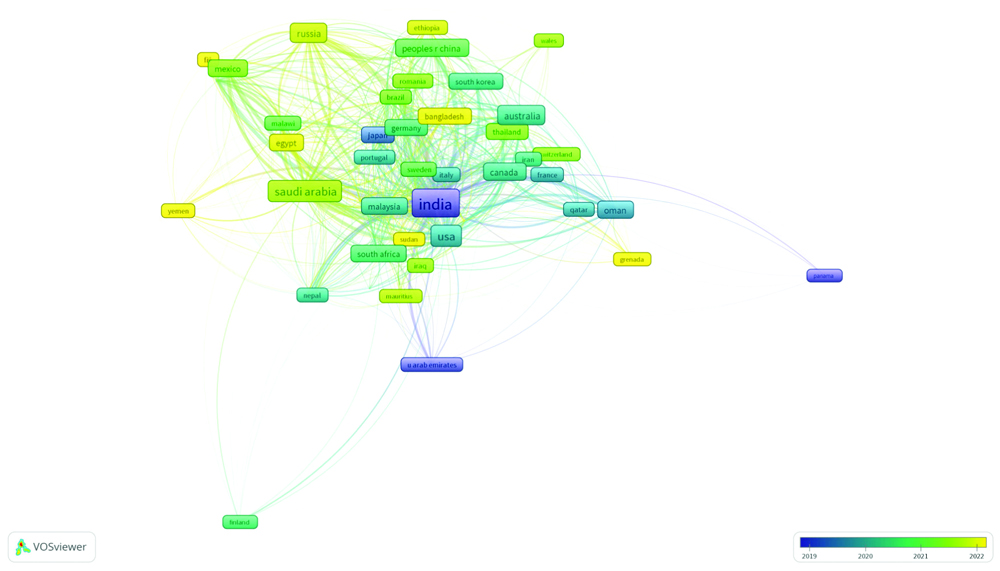
Trending Research Topics in JSSAHER
The analysis of trending research topics highlights an increasing focus on terms like “in vitro,” “prevalence,” “oxidative stress,” “nanoparticles,” and “COVID-19” in recent years, reflecting the institution’s adaptation to emerging scientific challenges. Earlier research concentrated on topics such as “molecular docking” and “antioxidants,” which peaked around 2010-2015. These trends underscore JSSAHER’s evolving research priorities, bridging foundational studies with contemporary issues in health sciences and technology [Table/Fig-14].
Trending research topics in JSSAHER.
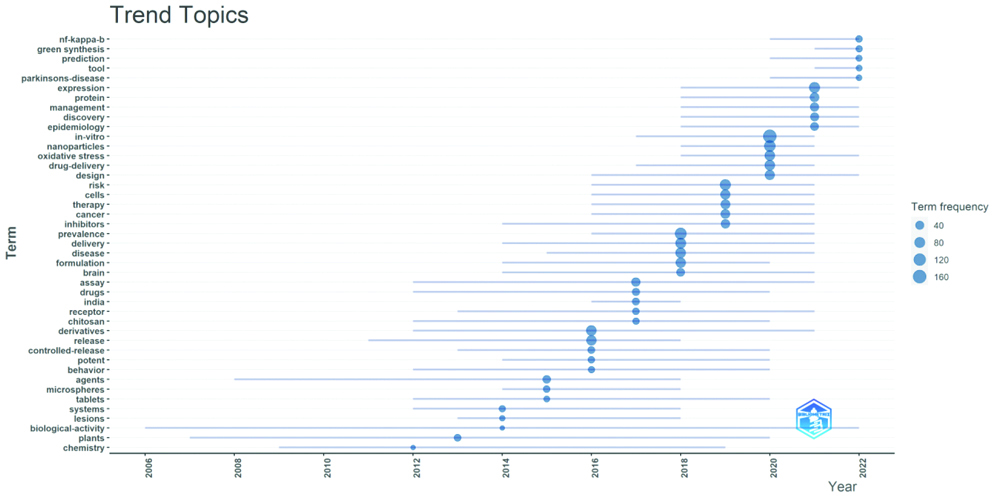
JSSAHER’s Research Contribution to the Sustainable Development Goals (SDGs): A comprehensive analysis
In [Table/Fig-15], JSSAHER’s research predominantly supports Good Health and Wellbeing (SDG 3), with 80.89% (3786) of its publications addressing health-related goals. Other notable contributions include Gender Equality (SDG 5) with 3.97% (186) and Clean Water and Sanitation (SDG 6) with 1.83% (86). Research aligned with Sustainable Cities and Communities (SDG 11) and Quality Education (SDG 4) also reflects the institution’s diverse focus. However, 13.41% (628) of publications are not directly linked to the SDG goals, highlighting an opportunity for broader alignment with sustainability initiatives.
JSSAHER’s Research Contribution to the Sustainable Development Goals (SDGs).
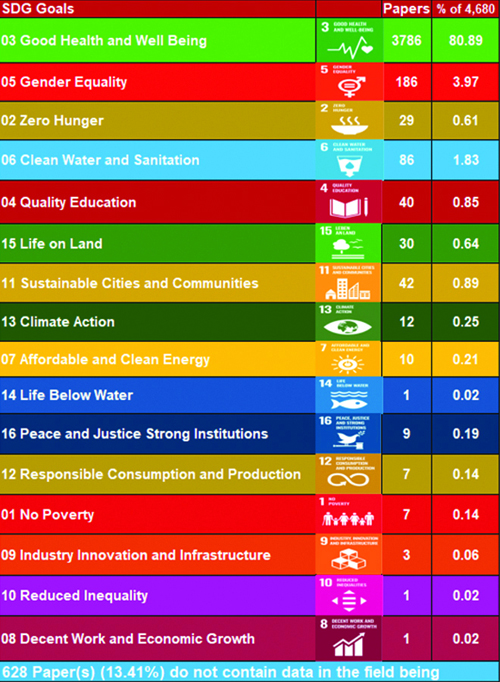
Research Gap
The analysis reveals several research gaps that warrant further investigation. Firstly, there is a disparity in the production of documents by single authors compared to those with multiple authors. Further studies could explore the factors contributing to higher or lower collaboration among authors and assess the impact of collaboration size on research outcomes. Additionally, there is a need to focus on lesser-explored themes or emerging areas, such as microglial studies, serotonin, seizures, chirality, dysphagia, and dyslipidaemia. While collaboration among Indian authors is relatively high, international collaborations remain limited, presenting an opportunity to foster and expand global partnerships.
Furthermore, understanding the factors driving the sudden rise or fall of specific research topics could provide valuable insights into the evolution of research priorities. The absence of certain topics in the early years highlights the potential for longitudinal studies that encompass earlier periods. Another significant gap is the limited research addressing critical social and economic sustainability goals. Future research could investigate why specific SDGs, particularly those related to socio-economic challenges, have received less attention. Finally, although pharmacology and pharmacy are well-represented, other disciplines like oncology and public health are relatively underexplored, emphasising the need to expand interdisciplinary research.
Discussion
The results of this study provide a comprehensive analysis of JSSAHER’s contributions to global research, emphasising the trends, collaborations, and thematic areas of focus. Drawing parallels with related bibliometric studies, the results underscore the dynamic and evolving nature of institutional research outputs in higher education [18-20]. The annual rate of growth in JSSAHER publications, at 13.87%, places it on the same higher learning curve of global academic trends as depicted by research on the internationalisation of higher education and leadership development [21,22]. Similar to other institutions of learning focusing on both sustainability and internationalisation, resilience and adaptability to emerging global challenges are well depicted in the thematic diversity of JSSAHER’s publications [23,24].
JSSAHER’s collaboration with countries such as the United States, Saudi Arabia, and the United Kingdom indicates that international partnerships play an important role in developing the research visibility and impact of any university. This corresponds with findings from global studies on university-industry and cross-border research collaborations [25,26]. In fact, such collaborations not only help increase citation metrics but also foster innovation in tackling transnational issues such as public health and sustainable development [27].
A strong emphasis on keywords such as oxidative stress, nanoparticles, and prevalence indicates JSSAHER’s contributions to biomedical and pharmaceutical sciences, considering the global trends within health sciences research. Typically, niche areas attract significant academic and practical interest globally, as evidenced by bibliometric analysis that focus on issues related to health sciences, such as medical education and first-generation college student research [15,28].
The interdisciplinary research conducted by JSSAHER reflects the institution’s alignment with global priorities such as the SDGs. The contributions made by this institution to SDG 3 (Good Health and Well-being) and SDG 4 (Quality Education) are found to relate to bibliometric studies that indicate a relationship between academic research and sustainability initiatives [22,27].
Expanding international collaborations to underrepresented regions such as Africa and South America can help diversify its research portfolio and have a greater impact on the world. An increased emphasis on emerging fields such as artificial intelligence in healthcare and precision medicine could position JSSAHER at the forefront of cutting-edge research. A greater focus on high-impact journals and funding collaborations would further enhance citation metrics and institutional rankings.
Limitation(s)
While the study provides a strong analysis of JSSAHER’s research output, it is constrained by its reliance on a single bibliometric database, the Web of Science. Further studies could integrate data from Scopus and PubMed to provide a more comprehensive view. Additionally, qualitative analysis of key publications could offer deeper insights into the institution’s research impact.
Conclusion(s)
The scientometric analysis provides valuable insights into the research landscape of JSSAHER, revealing key trends, collaborations and gaps across various disciplines. The research progress of JSSAHER has continued at a very high level, which can be clearly understood through scientometric analysis. From 1996 to 2023, research has grown significantly, with many countries collaborating to expand studies in various fields. JSSAHER has demonstrated a strong global presence in its research area through citation analysis, co-citation networks, trend topics and country-wise analysis. These findings reflect numerous research efforts, particularly in the fields of health, medicine, pharmacology and biology. The results of citation and keyword analysis will help uncover new avenues in the field of medical research, assisting in raising the global research profile of JSSAHER. In relation to the SDGs, the analysis reveals a strong emphasis on “Good Health and Wellbeing,” but a noticeable gap is found in research addressing socio-economic sustainability goals. This highlights the need to foster research that more comprehensively addresses a wider range of SDGs.
Conclusion(s)
Present study showed significantly decreased odds of COVID-19 positivity in vaccinated individuals. The reduction in odds of testing positive for SARS-CoV-2 was found to be dose dependent, with individuals receiving two doses of the vaccine showing lower odds of COVID-19 positivity versus individuals receiving one dose. Though the COVID-19 pandemic is at the cusp of endemicity with the risk of emergence of new variants, constant surveillance and further studies aimed at understanding the role of the vaccine in preventing infection and disease transmission will better equip us for future challenges.
ACD: Average citations per documentTD: Total documents; TC: Total citations; CPD: Citations per documents; HI: h-Index; ICD: International collaborative documents; TLS: Total link strength; RCI: Relative citation indexTC: Total citations; NP: Number of publications; PY_start: First article published yearTCpY: Total citations per year